Basic Dungeons & Dragons
While Gygax was busy making "Advanced" Dungeons & Dragons, a doctor named John Eric Holmes worked on the original rules (plus Supplement I) with the intention of producing a single volume as an introduction for beginners. Holmes' Basic D&D (1977) was to be followed in 1981 by Basic and Expert D&D, edited by Tom Moldvay. Between 1983 and 1985, Frank Mentzer turned out the BECMI series. While often derided as "Kiddie D&D", sales of the basic version exceeded those of the Advanced version for a few years. The system was a stepped system, meaning you could just buy the Basic book at a relatively low cost (around $7) and if you wanted to advance your character past level 3, you could buy the Expert books and so on. Each book in each set was available separately.
Frank Mentzer BECMI
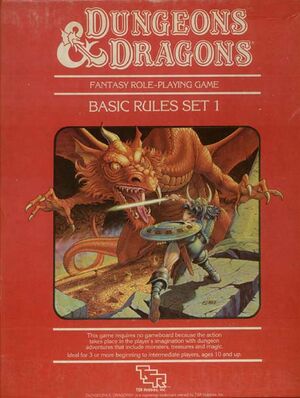
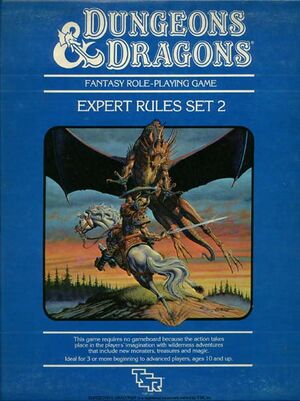
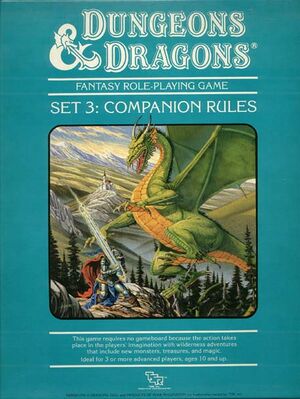
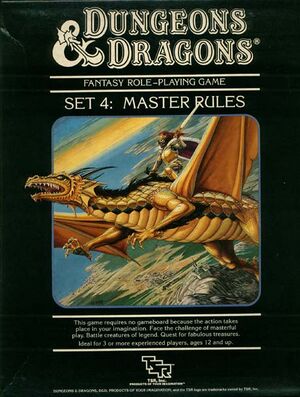
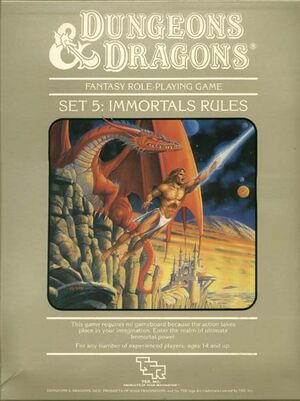
Basic Set
This had everything you needed for characters level 1-3. It included a rulebook and an adventure (Keep on the Borderlands). The later Metzner version split the rulebook into a Players book and a DMs book (which were written as tutorials) and replaced the adventure with an unfinished one, where you try to avenge an NPC cleric Aleena on her murderer, a Magic-user named Bargle. It is a continuation of the Players' tutorial solo adventure (which was beneficial if you lacked players, and also inspired adventure gamebooks and invisible ink adventures like M1 Blizzard Pass). Some printings had 3 hole punch in the books to allow people to keep them in a binder easily. It also included a set of inexpensive dice that you colored in with a crayon. The books only printed material relevant for characters from levels 1-3 and so were much smaller than the average RPG book. This allowed them to be sold cheaply. Character classes included Fighter, Cleric, Magic-user, Thief, Dwarf (fighter with infra-vision and badass saving throws), an Elf (fighter/magic-user) or Halfling (proto-Ranger). Your alignment choices were Lawful, Neutral, or Chaotic.
Expert Set
This allowed you to advance from level 4 to level 14.
It came with another module (X1 Isle of Dread) and another set of dice.
It added a few more rules and more material relevant to characters of mid level.
Added combat rules for charging, using mount lances, or setting a spear to receive a charge. Introduced monsters with multiple attacks that could drain 2 levels per attack, instant kill poisons, and other things that made us hate our DM.
Demi-human characters (Elf, Dwarf, and Halfling) could not advance in level past this set, although by the end of it they had impressive saves and fair hit points. Their fighting ability continued to improve in later sets, so you weren't totally boned for playing subhuman filth.
Companion Set
Levels 15-25 were covered here.
If you bought the box set you got another set of dice as well, say some people, but I never got any.
Higher level magic, more monsters and such. Rules for tricking out your Lawful Fighter as a Paladin, your Chaotic Fighter into a sort of anti-paladin named an Avenger, your Neutral Cleric into a Druid, etc. The DMs' book included two mini adventures- a tournament featuring a knight named Sir Guy de Gax, and a pit-fighting adventure that forbade spellcasting.
Master Set
Levels 26-36.
This was for super high level campaigns.
The largest and nastiest monsters, the most powerful spells and rules for even running your own settlements. The players' book added about 20 overpowered polearms with pictures of every one, so you had no excuse for not knowing what a Lochaber Axe is. The "Roll to Hit" tables were extended out to show what was needed to hit AC -20 (of all things), and some of them had printing errors. Hope you packed your magical bonuses! There were rules for making a Thief into an Assassin, which you could then never play, for it was Evil (tm). Although some people can't find those rules in their copy, only finding "Headsmen" and "Thug" monster-type NPCs for the DM to use. There were epic quests to become the greatest of your class, including one called "the Polymath", where your Magic-User had to advance to level 36 in each of the other classes to become a 36/36/36/36 everything. And they had a few artifacts like the Armet of Wayland.
Box set came with another set of the cheap, easily destroyed Crayola Dice, unless you were me.
Immortals Set
For when levels mean precisely dick-all.
This has rules for gods. It has to, who else is going to stand up to you?
Another set of dice in this box, along with writeups on classical gods of mythology.